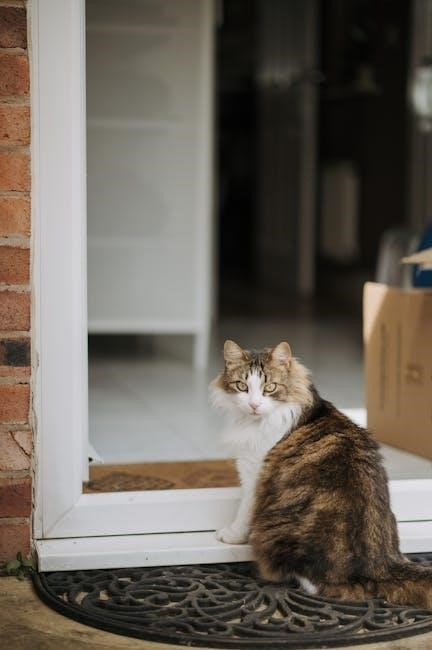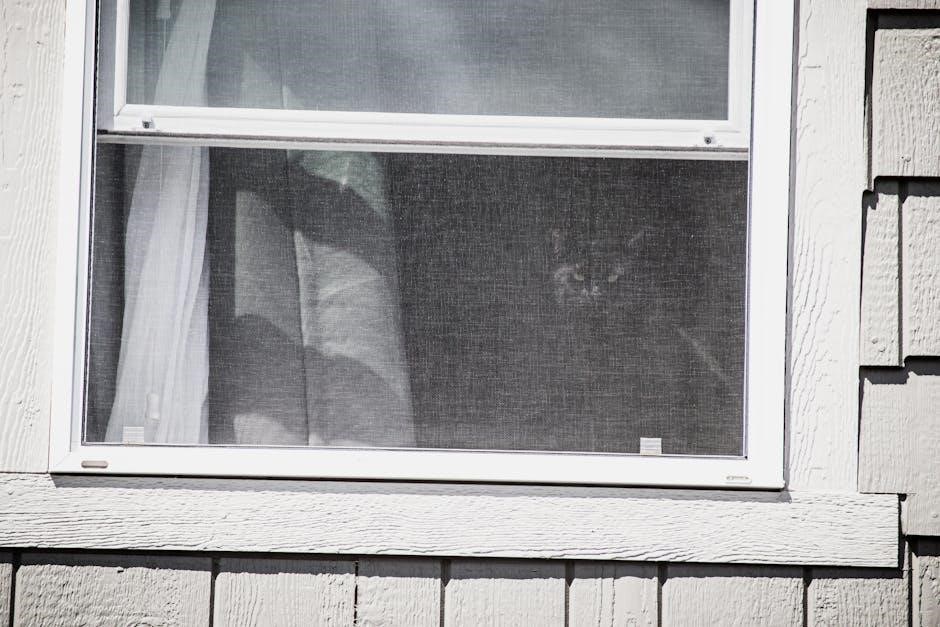cat house plans pdf
Discover the best cat house plans PDF guides online, offering free DIY designs for insulated, cozy shelters. Perfect for feral or domestic cats, these step-by-step plans ensure warmth and protection.
Why Cat Houses Are Essential for Feral and Domestic Cats
Providing a safe and cozy shelter is crucial for both feral and domestic cats. Outdoor cats often face harsh weather conditions, such as freezing winters and heavy rains, which can threaten their health. A well-built cat house offers protection from the elements, ensuring warmth and dryness. For feral cats, these shelters can be a lifeline, providing a secure space to rest and hide from predators. Domestic cats also benefit from outdoor houses, as they offer a safe retreat while exploring. Cat houses help reduce the risk of hypothermia, keep cats clean, and provide a sense of security. They are a simple yet effective way to improve your cat’s quality of life.
Overview of Free DIY Cat House Plans Available Online
Free DIY cat house plans are widely available online, offering a variety of designs to suit different needs and skill levels. These plans cater to both indoor and outdoor setups, providing detailed instructions for building cozy shelters. Many designs include features like insulation, roofs, and ventilation to ensure comfort and safety. Additionally, some plans offer downloadable PDF guides, making it easy to print and follow instructions. Whether you’re a beginner or an experienced builder, these plans provide a cost-effective way to create a safe haven for your feline friends. They often include material lists and step-by-step assembly tips, ensuring a successful project.

Types of Cat Houses You Can Build
Explore various cat house designs, from indoor and outdoor shelters to insulated, multi-story, and luxury options with verandas and scratching posts for ultimate feline comfort.
Indoor Cat House Plans for Small Spaces
Optimize limited space with indoor cat house plans designed for small areas. These compact designs feature wall-mounted or multi-level structures, perfect for apartments or cozy rooms. Use materials like wood or cardboard to create a snug retreat. DIY plans often include space-saving features such as foldable roofs or hidden compartments. Add soft bedding for comfort and incorporate scratching posts to keep your cat active. These indoor cat houses are easy to build, even for beginners, and provide a warm, secure spot for your feline friend to rest and play. Ideal for domestic cats, they blend seamlessly into any home decor while ensuring your cat’s happiness.
Outdoor Cat House Plans for All Seasons
Create a cozy and durable outdoor cat house with plans designed for every season. From winter-insulated shelters to summer-friendly designs, these DIY plans ensure your cat stays comfortable year-round. Choose from designs featuring tilted roofs for rain runoff, insulated walls for warmth, and breathable materials to prevent humidity. Some plans include solar-powered options or heated elements for colder climates. Easy-to-follow guides help you build a sturdy shelter using weather-resistant materials like wood or plastic. These outdoor cat houses are perfect for feral or domestic cats, offering protection from harsh weather while blending into your yard’s landscape. Ensure your cat has a safe retreat with these versatile and practical designs.

Materials and Tools Needed for Building a Cat House
Gather essential materials like wood, insulation, and roofing, along with tools such as saws, drills, and hammers. These ensure a sturdy and insulated cat house structure.
Essential Materials for Insulated Cat Houses
Building an insulated cat house requires durable materials like exterior-grade plywood, foam insulation, and waterproof roofing. Use weather-resistant wood for the frame and walls to ensure longevity. Add insulation to the floor, walls, and roof for optimal warmth. A waterproof coating on the roof protects against rain and snow. Include a bed of straw or fleece for added comfort. Metal hardware and hinges ensure secure doors and openings. For extra protection, incorporate vinyl or plastic shielding around the exterior. These materials create a cozy, safe shelter for cats, keeping them warm in winter and cool in summer.
Tools Required for DIY Cat House Construction
Building a cat house requires essential DIY tools like a circular saw, drill, and screwdriver for cutting and assembling wood. A hammer, tape measure, and square ensure accurate cuts and alignment. Sandpaper smooths rough edges, while a staple gun secures insulation or bedding. For detailed work, a jigsaw or utility knife may be needed. Safety gear like gloves and goggles is crucial. Optional tools include a router for decorative edges or a paintbrush for finishing. Gather all tools beforehand to streamline the process. Proper equipment ensures a sturdy and comfortable shelter for your cat.

Step-by-Step Instructions for Building a Cat House
- Measure and cut wood according to your chosen plan.
- Assemble the frame using screws or nails.
- Attach walls and ensure sturdy construction.
- Add a roof for weather protection.
- Install insulation for comfort and warmth.
How to Assemble the Frame and Walls
Start by cutting the wood according to your cat house plans PDF. Use screws to secure the frame, ensuring it’s square and sturdy; Attach the walls one by one, aligning edges carefully. For outdoor shelters, use weatherproof materials. Add a floor and back panel for stability; Nail or screw walls into place, ensuring no gaps. Sand rough edges for safety. If building for insulation, line the frame with thermal materials. Double-check all corners and seams to ensure a snug fit. This step forms the foundation of your cat house, so precision is key for durability and comfort.
Adding a Roof and Insulation for Maximum Comfort
Cut the roof panels to size and attach them securely using hinges or screws. For insulation, line the walls and floor with foam board, straw, or thermal insulation materials. Ensure the roof is angled to allow water to run off. Add a layer of protective waterproof glue and UV-resistant sealant for durability. For extra comfort, install a bed of soft bedding like straw or fleece. Proper insulation keeps the cat house warm in winter and cool in summer, ensuring your cat’s comfort year-round. Follow the cat house plans PDF for precise measurements and techniques to achieve a snug, weather-tight shelter.

Safety Tips for Building and Placing a Cat House
Use non-toxic materials and secure structures to prevent tipping. Ensure proper ventilation and avoid placing shelters in flood-prone or harsh weather-exposed areas for your cat’s safety.
Choosing the Right Location for Outdoor Shelters
When building an outdoor cat house, location is crucial for your cat’s safety and comfort. Choose a spot protected from harsh winds, rain, and direct sunlight. Ensure the shelter is elevated slightly to prevent water accumulation and placed in a quiet, secluded area to reduce stress. Avoid flood-prone zones and areas with heavy foot traffic. Proximity to food, water, and litter sources is essential. Consider positioning the shelter near a building or tree for added protection. Always ensure the location is accessible for maintenance and cleaning. By selecting the right spot, you create a safe and welcoming space for your feline friend.
Ensuring Ventilation and Protection from the Elements
Proper ventilation is essential to maintain a healthy environment inside your cat house. Adding small gaps or vents ensures airflow, preventing moisture buildup and odors. For outdoor shelters, use waterproof materials like asphalt roofing or sealed wood to protect against rain and snow. A sloped roof helps water run off, while insulation keeps the interior warm in winter and cool in summer. Position the shelter to shield from strong winds and direct sunlight. Elevated bases or tilting floors can help prevent water seepage. Always secure the structure firmly to avoid movement during storms. These steps ensure your cat house remains dry, cozy, and safe year-round.
Customizing Your Cat House for Unique Needs
Add beds, scratching posts, or multi-level structures to create a tailored space. These features enhance comfort and cater to your cat’s unique preferences and playful nature.
Adding Beds, Scratching Posts, and Other Features
Customize your cat house with cozy beds for comfort and scratching posts to keep nails healthy. Add multi-level structures for playful cats or insulation for colder climates. Consider eco-friendly options like solar-powered features or recycled materials. These additions create a tailored space that meets your cat’s unique needs and preferences. Ensure all features are sturdy and safe, using non-toxic materials. DIY plans often include optional add-ons, allowing you to personalize the shelter. Whether for indoor or outdoor use, these enhancements make the cat house a welcoming and functional home for your feline friend.
Creating a cozy cat house using PDF plans is a rewarding project that provides warmth and shelter. These guides offer easy-to-follow instructions for a safe, comfortable feline home.
Final Thoughts on Creating a Cozy Home for Your Cat
Building a cat house using cat house plans PDF is a thoughtful way to provide your feline friend with a safe, warm, and comfortable space. Whether for a domestic cat or a feral colony, these plans offer practical solutions. With step-by-step guides and customizable designs, you can create a shelter that meets your cat’s unique needs; From insulated walls to cozy bedding, the details matter for their comfort. By investing time and effort into this project, you’re giving your cat a sense of security and a place to thrive. It’s a rewarding way to show your cat how much you care.
